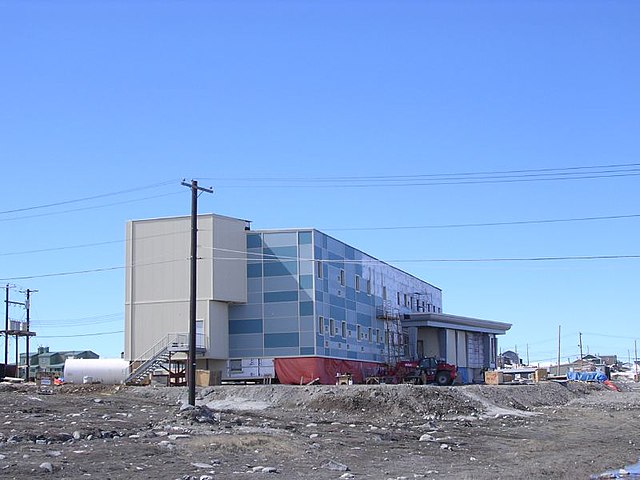
As mining activity expands in northern Labrador, COVID-19’s ‘new normal’ difficult to accept for Nunatsiavut Inuit communities
by Matthew Pike, PhD Candidate, Department of Population Medicine, University of Guelph
How can, and why should, Nunatsiavut accept a “new normal” when there never was equal access to health care to begin with?

Kivalliq Regional Health Care, Nunavut. Wikimedia Commons.
At the onset of the COVID-19 pandemic, mining giant Vale shut down its Voisey’s Bay mine for three months to protect the health and well-being of its employees and the nearby Nunatsiavut Inuit communities.
With the arrival of the highly contagious Omicron COVID-19 variant and subvariants, health officials conceded that most people will likely to get COVID-19.
The Government of Newfoundland and Labrador has since provided guidance that residents will have to live with this “new normal” and make personal choices based on their own situations.
As a Nunatsiavut beneficiary, a public health researcher and, until recently, a member of the Vale team managing COVID-19 in Voisey’s Bay, I believe more attention to impacts of living with this “new normal” in Nunatsiavut is critically necessary to protect the health and well-being of communities.
Managing COVID-19 in Voisey’s Bay
Voisey’s Bay is a fly-in/fly-out nickel, copper and cobalt mine located near Nain, Nunatsiavut, the northernmost community in Newfoundland and Labrador with approximately 1,100 (mostly Inuit) residents.
With a $2 billion mine expansion underway, there were approximately 900 employees in Voisey’s Bay at the onset of COVID-19. When it shut down, Vale sent home most employees with pay, and we immediately began the work to safely re-open the mine, which happened three months later.
Like other mines in Inuit Nunangat, Voisey’s Bay invested in an on-site PCR testing laboratory and electronic contact tracing badges that can list close contacts in minutes. We implemented a mandatory mask and vaccination policy, increased the on-site medical team, increased isolation rooms and many other precautions you can implement while still operating a mine. In fact, Vale was awarded Miner of the Year for its management of COVID-19.
Managing COVID-19 in Voisey’s Bay was relatively simple until the arrival of the Omicron variant.
Our team worked tirelessly to keep Voisey’s Bay a COVID-zero site, but on Dec. 21, 2021, the first case was confirmed. It became clear that COVID-19 was coming and we needed to prepare to manage it as effectively as possible.
Despite this, the mine went from having its first COVID-19 case in December to having over 90 confirmed cases with more than 70 close contacts in isolation in late March, two weeks after pandemic restrictions eased in Newfoundland and Labrador.
Should Vale shut down again? Send everyone home with pay again?
Impact on employees, their families and communities
An obvious impact of a mine shut-down on employees would be the likely loss of income, and income is arguably “the most important determinant of health.” Since the mine expansion began in 2018, the number of Inuit workers has doubled, increasing the dependence on and importance of Voisey’s Bay for Nunatsiavut Inuit.
As one of the largest and highest-paying employers in the region, shutting down will likely mean the overnight removal of some of the highest-paying jobs, a lost sense of purpose and financial hardship for employees and their families. Essentially the worst parts of the “bust” for the traditional “boom and bust” economies.
While some employees said Vale has gone “above and beyond” in managing COVID-19, a mining company is not, and should not, be responsible for the delivery of health care.
The reality for Nunatsiavut employees is they are forced to bear the burden of potentially bringing COVID-19 to their communities when they fly back from a two-week work shift at the mine. These are communities that are still not equipped to handle a serious case of the disease. If someone requires advanced care, such as a ventilator, they will need to be flown south via air ambulance, a service that has been described recently as a “chronic failure.”
How can, and why should, Nunatsiavut accept a “new normal” when there never was equal access to health care to begin with?
Moving forward
While the rest of Canada eases into a “new normal,” it will be difficult for communities and mining sites in Nunatsiavut to do the same. As Vale continues to expand and new companies begin exploring for new deposits, the increase of fly-in/fly-out workers coming to Nunatsiavut likely means that COVID-19 in Nunatsiavut is here to stay.
The Government of Newfoundland and Labrador and Government of Canada have long known that healthier Inuit communities can be achieved through addressing the social determinants of health. They also should be aware of the increased risk Inuit face during a pandemic due to, among other things, chronic housing shortages leading to overcrowding and the inability for many to self-isolate, pre-existing high rates of respiratory illnesses, high rates of tobacco use and an already fragile health-care system.
A clear indication that the message of accepting this “new normal” is not sitting well in Nunatsiavut came from Lela Evans, the region’s representative in the provincial legislature. Evans recently said she would not accept Newfoundland and Labrador’s apology for its role in residential schools until there’s “real reconciliation,” including access to quality health care.
Without investments into addressing the social determinants of health, including access to advanced health care, the “new normal” does not bode well for Nunatsiavut.
This article is republished from The Conversation under a Creative Commons license. Read the original article.